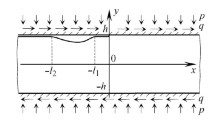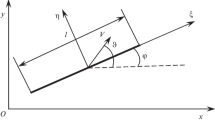Summary
A problem of partial sliding along a planar crack with a local drop in frictional resistance is investigated. A sliding zone initiates in the area of reduced friction, and then propagates as the applied shear load is monotonously increased. The problem is formulated in general terms, and then solved for the case when sliding spreads as a penny-shaped zone. Conditions under which the front of the zone stays circular during sliding are analyzed. It is observed that the axisymmetry of the profile of frictional resistance does not necessarily guarantee uniform propagation of sliding in the radial direction. The circular shape becomes the most favorable growth condition only if the shear modes are related in a certain way. The problem is studied based on the criterion of propagation that stress intensity factors(SIFs) for II and III modes vanish on the boundary of the sliding zone. The singular integrals in expressions for the SIFs are reduced to non-singular ones. Analytical solutions are derived for a number of special cases where the radius of the sliding zone is related to the applied shear load.
Similar content being viewed by others
Author information
Authors and Affiliations
Corresponding author
Additional information
This work is supported by the National Science Foundation through grant DGE-0209543 to the University of New Mexico.
Rights and permissions
About this article
Cite this article
Popova, M., Gorbatikh, L. On partial sliding along a planar crack: the case of a circular sliding zone. Archive of Applied Mechanics 73, 580–590 (2004). https://doi.org/10.1007/s00419-003-0309-2
Received:
Published:
Issue Date:
DOI: https://doi.org/10.1007/s00419-003-0309-2




